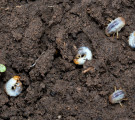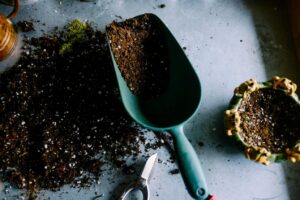Summer showdown: Protecting your lawn from pests and diseases

Maintaining a beautiful, healthy lawn during the summer can sometimes be challenging. Not only can the weather play a significant factor, but the presence of pests, weeds and lawn diseases can exacerbate the situation even further. However, with proper care and proactive measures, you can effectively combat these common garden intruders. Cheryl Harper, Managing Director of Greensleeves Lawn Care, has the following advice to help keep the pests at bay and maintain a lush lawn all summer.
Chafer bugs – what are they and what are the signs to look out for?
One of the most common and disruptive lawn pests at this time of year is the chafer grub. Chafer grubs are seasonal pests known to cause havoc on even the most well-tended lawn. They are the larvae of the chafer beetles which hatch from their eggs in June and July. These white, C-shaped grubs are often found in lawns and feed on the roots of grass. During the summer months, the newly hatched grubs will feed vigorously close to the surface of your lawn.
Signs of chafer grubs include patches of dead or dying grass that can be easily lifted, as well as increased bird, fox or badger activity as they’re attracted to the juicy grubs. If left unchecked, chafer grubs can cause significant damage to your lawn, resulting in brown patches and a weakened root system. If they survive through to the cooler autumn months they will burrow further down into the root system for the winter, before emerging in the spring to feast and wreak havoc all over again.
Chafer bugs are hard to identify and even harder to remove. An insecticide treatment is the best solution for tackling these intruders. This treatment can only be administered by a professional lawn care expert, such as Greensleeves. Combine with a spiking treatment for the best results.
Weed watch: Developing a keen eye for defending your lawn
During the summer, the garden is at its most active and alive, but sadly, that can mean weeds too. Weeds can appear in even the most well-kept gardens. Seeds can be brought into your garden by pets, birds, wildlife, or even carried in on the soles of shoes. They may pop up even after you’ve triumphed over them before.
There are a host of weeds to look out for. Not all of them are bad. Some contribute to soil health or can be aesthetically pleasing, but quite a lot will be damaging the health of your lawn. It is important to accurately identify and correctly treat the weeds in your garden. Many weeds can thrive in harsher conditions. In hot weather, they’ll steal sunlight, nutrients and water away from your grass. And whilst the weeds will thrive in these harsher conditions, your lawn will not.
Summer lawn diseases – the unwelcome guests at the garden party
There are several lawn diseases to be aware of, but some of the more common ones include red thread, brown patch, rust disease, and fairy rings. Red thread manifests as a cottony russet fungus on the grass blades, often indicating a nitrogen-deficient soil. It is prevalent during wet summers and autumn, although it can occur throughout the year.
Brown patch fungus, on the other hand, is a destructive disease that quickly spreads and damages large areas of the lawn. It lies dormant in winter plant debris, infecting the lawn during mowing, and thrives in the humidity of summer, affecting all grass types. It starts as circular brown patches ranging from a few inches to several metres in size.
Rust disease, caused by airborne spores, affects most turfgrass varieties and is amongst the most common fungal diseases of garden plants. It tends to emerge during spring or late summer and early autumn when grass growth is slower. It’s more likely to occur in dry conditions and nitrogen-deficient soil. Yellow patches and orange spore-producing fungi become visible on the leaves, which turn black as winter approaches.
Lastly, fairy rings are collections of fungal fruiting bodies that typically emerge in the summertime, forming circles of toadstools and dead grass up to 10 metres in diameter.
It’s important to note that proper lawn care practices, such as regular mowing, adequate watering, and appropriate fertilisation, can help prevent and manage these diseases. If you suspect a lawn disease, it is best to consult with a local lawn care professional. For further information about Greensleeves and how they can help you with your lawn care, visit www.greensleeves-uk.com/





